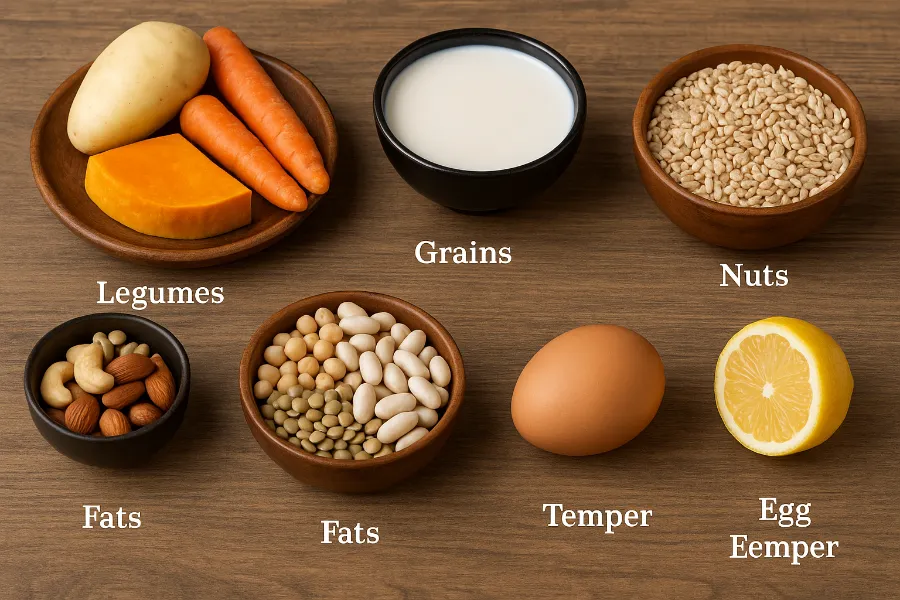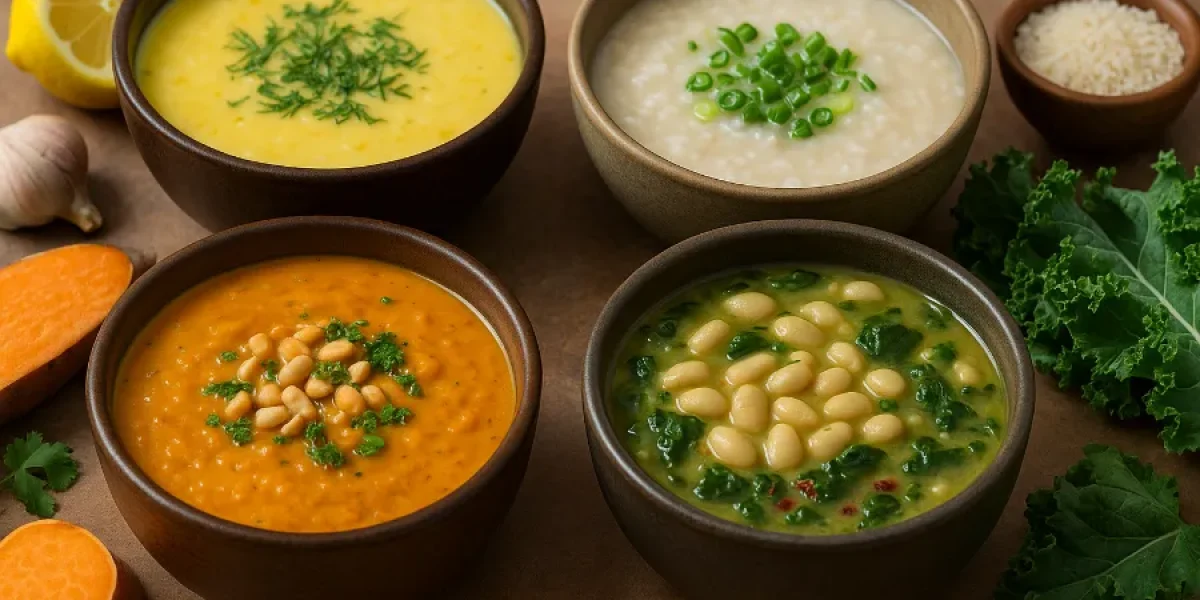There’s nothing worse than ladling out a soup that feels more like flavored broth than a comforting meal. I’ve been there—standing over the stove, tasting and hoping it will somehow thicken itself. That’s when I learned the best secret of all: you can make any soup luxuriously creamy without ever touching flour or cornstarch.
If you’ve been wondering how to thicken soup without flour or cornstarch, you’ll be glad to know that some of the most flavorful, creamy soups around the world rely entirely on natural ingredients—beans, potatoes, grains, nuts, and even eggs. These simple methods add body, richness, and flavor without relying on processed starches.
Let’s talk about the many ways to make a creamy soup from scratch. Whether you’re looking for a gluten-free option, a vegan version, or global recipes for inspiration, you’ll find plenty of ideas here.

Thicken Soup Naturally: The Basics
The goal of any good thickening method is texture—silky, rich, and full-bodied without tasting heavy. Instead of masking flavor, a natural soup thickener should enhance it.
Here are the most dependable natural ways to thicken soup:
- Blend cooked vegetables such as potatoes, carrots, or cauliflower into the base.
- Use beans or lentils for a creamy, protein-rich texture.
- Stir in coconut milk or nut-based creams for plant-based luxury.
- Simmer uncovered to let excess liquid evaporate and the flavors deepen.
These methods don’t just create thickness; they build complexity and depth. That’s why homemade soups tend to taste better than anything you can pour out of a box.
Homemade Soup Secrets
When making homemade soup, think in layers. Start with a flavorful base, then thicken gradually. Roasting or sautéing your vegetables first adds sweetness and helps them blend into a naturally creamy texture.
My go-to method is simple: roast carrots, potatoes, and garlic until golden, then simmer them in broth. Blend most of the soup but leave some chunks for texture. Finish with a drizzle of olive oil. It’s creamy, rustic, and deeply satisfying without cream or flour.
Gluten Free Soup That’s Naturally Creamy
Many cooks think gluten-free means giving up on creamy comfort, but that couldn’t be further from the truth. A gluten free soup can be thick and rich if you use whole ingredients that do the job naturally.
Try any of these:
- Pureed white beans or chickpeas
- Blended root vegetables like parsnips or turnips
- Coconut milk or cashew cream for a dairy-like smoothness
These ingredients add both substance and nutrition. You’ll end up with a soup that’s not just thicker, but also heartier and more flavorful.
Vegan Soup That Feels Indulgent

A vegan soup doesn’t need dairy or starch to be indulgent. Many classic plant-based soups rely on natural thickeners to create their creamy texture.
Here are a few examples:
- Curried lentil soup thickened with red lentils and coconut milk
- Roasted cauliflower soup blended with garlic and tahini
- African peanut stew with sweet potatoes and crushed peanuts
Let’s pause on that last one—it’s one of my all-time favorites for achieving bold flavor and richness naturally.
African Peanut Stew Recipe
Ingredients:
- 1 onion, chopped
- 2 garlic cloves, minced
- 1 tablespoon grated ginger
- 1 cup unsweetened peanut butter
- 4 cups vegetable broth
- 2 cups diced sweet potatoes
- 1 can crushed tomatoes
- 2 cups chopped spinach
- Salt, pepper, and chili flakes to taste
Directions:
- Sauté onion, garlic, and ginger until soft and fragrant.
- Add sweet potatoes, tomatoes, and broth. Simmer until tender.
- Whisk in peanut butter until fully blended.
- Stir in spinach and season to taste.
This stew is thick, hearty, and entirely plant-based. It proves that nuts can create creaminess without any help from flour or cornstarch.
Thick Soup Recipe: Tuscan White Bean and Kale Soup
If you want to know how to make soup thicker without cream, beans are the answer. They create a silky base and add satisfying texture.
Ingredients:
- 2 tablespoons olive oil
- 1 onion, diced
- 2 garlic cloves, minced
- 2 cans cannellini beans, drained
- 1 bunch kale, chopped
- 6 cups vegetable broth
- 1 teaspoon rosemary, ½ teaspoon thyme
- Salt and pepper
Directions:
- Sauté onion and garlic until golden.
- Add broth, herbs, and beans. Simmer for 20 minutes.
- Blend half the soup until smooth and pour it back into the pot.
- Add kale and cook until tender.
This homemade soup thickens beautifully on its own. The blended beans create a creamy texture while the kale keeps it hearty.
Rice Porridge Soup (Japanese Okayu)
Sometimes the simplest method is the most comforting. In Japan, rice porridge soup, or Okayu, is a humble, healing meal that thickens naturally as rice breaks down.
Ingredients:
- ½ cup short-grain rice
- 4 cups broth or water
- Salt to taste
- Optional toppings: sesame oil, scallions, or shredded chicken
Directions:
- Combine rice and liquid in a pot.
- Simmer gently for 45 to 60 minutes, stirring occasionally.
- When the rice grains have broken down, season and serve.
This method is perfect if you want to know how to thicken broth without adding any thickener at all. The starch from the rice does all the work.

Greek Avgolemono Soup Recipe
One of the most elegant examples of how to make soup creamy without flour comes from Greece. Avgolemono uses eggs and lemon to create a silky, tangy finish.
Ingredients:
- 6 cups chicken broth
- ½ cup rice or orzo
- 3 eggs
- Juice of 2 lemons
- 2 cups shredded chicken
- Salt and pepper
Directions:
- Simmer the broth and cook the rice until tender.
- In a separate bowl, whisk eggs and lemon juice.
- Slowly ladle a cup of hot broth into the egg mixture while whisking (this tempers the eggs).
- Pour the egg mixture back into the soup, stirring gently off the heat.
- Add chicken and season to taste.
This creamy soup has no dairy and no starch, yet it feels as rich as a sauce. It’s light, bright, and incredibly satisfying.
How to Thicken Soup Without Flour or Cornstarch
Here’s a quick guide to natural thickening methods that work every time:
| Method | What to Use | Texture |
|---|---|---|
| Blend vegetables | Potatoes, carrots, squash | Smooth and hearty |
| Add legumes | Beans, lentils, chickpeas | Creamy and filling |
| Simmer uncovered | Reduction | Concentrated and rich |
| Stir in fats | Coconut milk, olive oil | Luxurious and silky |
| Add grains | Rice, oats, barley | Subtly thick and comforting |
| Use nuts | Cashews, peanuts, almonds | Velvety and rich |
| Temper eggs | Egg yolks and lemon | Glossy and smooth |
These simple methods are timeless and work across cuisines. Once you try them, you’ll never reach for cornstarch again.
Soup Thickener Ideas from Around the World
Every culture has found its own way to thicken soup naturally. Here are a few global favorites:
| Country | Thickener | Soup Example |
|---|---|---|
| Italy | Bread and beans | Ribollita |
| Greece | Eggs and lemon | Avgolemono |
| Japan | Rice | Okayu |
| India | Lentils | Dal |
| West Africa | Peanuts | Groundnut Stew |
| France | Pureed shellfish | Bisque |
| Thailand | Coconut milk | Tom Kha Gai |
| Mexico | Beans | Sopa de Frijol |
These traditions show that a creamy texture doesn’t depend on modern shortcuts. The best results come from real food and slow cooking.
How to Make Soup Creamy Without Dairy
If you’re skipping dairy, there are plenty of natural ways to make your soup taste rich and smooth.
Try these:
- Pureed vegetables like cauliflower or carrots
- Cashew cream made from soaked and blended nuts
- Coconut milk for subtle sweetness
- Roasted ingredients for depth and natural thickness
These add creaminess and character without relying on cream or butter.
How to Make Soup Thicker: Real-Life Kitchen Tips
After years of experimenting, here are the tips that never fail:
- Simmer longer: Give it time to reduce and concentrate.
- Blend selectively: Purée only part of the soup to keep texture.
- Season at the end: Thick soups can dull salt, so adjust before serving.
- Finish with fat: Olive oil, butter, or coconut milk adds a final layer of richness.
These steps can transform an ordinary pot of soup into something restaurant-worthy.
How to Thicken Broth for Clear Soups
If you prefer clear soups like chicken or vegetable broth but still want a little more body, try these tricks:
- Simmer uncovered to reduce volume and enhance flavor.
- Add a handful of cooked rice or quinoa, simmer, and strain before serving.
- Add peeled potato chunks during simmering, then remove them—they absorb excess liquid and leave behind gentle thickness.
This approach keeps your soup light but satisfying.
Soup Ideas to Inspire You
If you’re ready to start experimenting, here are a few soup ideas to try next time you want something cozy and creamy:
- Moroccan Harira with lentils and chickpeas
- French Mushroom Bisque blended until smooth
- Thai Tom Kha Gai with coconut milk and lemongrass
- Mexican Sopa de Frijol made from blended beans
- Indian Dal Soup flavored with cumin and turmeric
Each of these proves that thick, comforting soup can be made entirely from natural ingredients.
How to Make Homemade Soup Feel Gourmet
The difference between a good soup and a great one is the finishing touch. Once your soup is thick and creamy, try these extras:
- Add croutons, toasted nuts, or seeds for crunch.
- Swirl in a bit of flavored oil like basil or chili.
- Top with a dollop of yogurt or cashew cream.
- Sprinkle fresh herbs or zest for brightness.
Those little details turn a simple meal into something that feels special.
Why Creamy Soup Is About More Than Texture
Learning how to thicken soup without flour or cornstarch isn’t just a cooking trick—it’s an approach to food that values patience and creativity. It’s about transforming humble ingredients into something beautiful, something that warms you from the inside out.
When you take the time to build flavor and texture naturally, you taste the difference in every spoonful. It’s not just a meal—it’s comfort, care, and craft in one bowl.
FAQs
You can use pureed vegetables, beans, lentils, coconut milk, or cashew cream. These add both texture and flavor without any starch or gluten.
Yes, coconut milk, blended nuts, or starchy vegetables like potatoes can create a smooth, creamy texture. These options are ideal for vegan or lactose-free soups.
Simmer the soup uncovered to reduce the liquid, or blend part of it to thicken naturally. You can also stir in mashed beans or cooked grains for extra body.
Blended white beans, pureed cauliflower, or cooked rice work perfectly as gluten-free thickeners. They provide a creamy finish without altering the flavor too much.
Try using cashew cream, coconut milk, or blended root vegetables. They add richness and a silky mouthfeel similar to dairy-based soups.
Soups like Greek avgolemono, African peanut stew, Japanese rice porridge, and Tuscan white bean soup are all naturally thick and flavorful. Each uses eggs, nuts, rice, or beans instead of starches.
Yes, simmering your soup uncovered allows excess liquid to evaporate, creating a thicker texture. This method also intensifies the flavor for a richer, creamier result.













